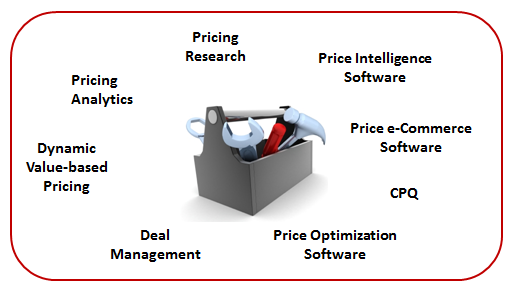
We’ve now established B2B distributors have tremendous opportunity in front of them if they pay attention to their level of differentiation in their value propositions and business models. When focusing on the right WOW differentiators, they can also play a productive role in their value chain and extract great pricing power.
Even with a great business model and opportunities for superior pricing power however, B2B distributors must identify the right profit nuggets and then go get that pricing power in the market. It will not come on its own, magically. For that, they need to pick the right tool box with the right pricing tools available in the box. Within B2B distribution, too many companies still consider pricing as an afterthought rather than as a strategic tool for business success.
Too often I encounter the following situations:
- Old fashioned price lists that are a mile long and can only be published once per year. Some of these price lists are still printed and mailed to thousands of customers and prospects.
- Static prices, often outdated, and lack transparency for internal users as well as for customers. This often leads to price lists that are not useful, not competitive, and shouts “call us for special pricing.”
- Prices that are set in Excel using an automatic cost-plus formula or margin-plus rule and then mass uploaded into distribution business software.
- Price deviations managed manually in the ERP system either in the master file itself at the customer level or at the order level and therefore not properly recorded in the customer pricing history.
- Long quotation process that is often manual, slow, and often lack specific, historical context.
For many years, distribution pricing has been done manually in Excel by customer service, sales, or the quoting department. This has worked well for decades. Today though, B2B distributors are facing digital disruption and the arrival of large digital native competitors like Google and Amazon. Both are well known for dynamic value-based pricing and strong capabilities in data analytics.
Amazon customers accept online prices to change constantly and dynamically. B2C customers have gotten used to Uber surge pricing as well as airline dynamic pricing. Yet, in B2B distribution, prices remain static, updated quarterly at best. It is time for these distributors to consider pricing as a strategic enabler of their business strategies and to make the relevant investments in a technological and methodological tool box as shown below.

4 Types of Pricing Tools
To improve the pricing power of the 21st century distribution business model, pricing must move from static to dynamic, from cost to value, from manual to system-based, and from experience-based to analytically-derived. Strategic pricing tools are no longer optional if you want to face and survive digital disruption. Here are 4 types:
- Pricing Analytical Platform: As I’ve mentioned, distributors are blessed with owning the customer relationship and with millions of transactions. This is a gold mine of information not only for the transactional data they collect but also for customer relationship data and market data.
- Price Optimization Software: The power is in your transactional data. Mining millions of data points can provide tremendous insights into your product mix, bundling, segmentation, and pricing strategy. The data will guide you on how to do peer pricing and will identify nuggets of pricing power that you can quickly capture.
- Dynamic, Value-based Pricing: Because you have transactional data and plenty of relevant customer data, start thinking in terms of customer value. Powerful customer information can be combined with your transactional data to identify additional areas of pricing power based on customer behaviors, purchasing patterns, market pressures, etc. Prices can by dynamically updated based on these value nuggets.
- CPQ: Automating your quotation system based on rapid configurations of your offers is essential especially when you sell systems and solutions. Truly integrating the configurating, pricing, and quoting functions in your business with an Intelligent CPQ solution can add tremendous speed to your distribution business, can relieve the stress on your sales staff, and boost your customer satisfaction.
To some, this may sound expensive! But remember, it takes money to make money. It also takes a strong commitment to become the best of the best in pricing. But when you consider that Amazon changes millions of pricing conditions daily, it is impossible to continue to manually manage pricing levels once per quarter and be successful.
This transition has been done successfully by some of the best in class B2C retail companies that have invested in dynamic pricing capabilities and, while they are at it, reshaped their business model. How can you justify making strategic investments in supply chain software, warehousing space, shipping automation and, at the same time, continue to manage millions of pricing conditions manually in Excel? It doesn’t make sense.
This is a wake-up call for B2B distribution. As you are making strategic resource plans for the next 3 to 5 years, make sure you include the concept of incremental investments in the strategic pricing tool box. It is a matter of survival to be able to compete better and dynamically versus your current and future competitors.
If you’re responsible for the profitability of your distribution business and you are feeling the pressure from inside and outside your organization, join Stephan Liozu and Vendavo for the Distribution Disruption Forum on October 30 in Chicago.

